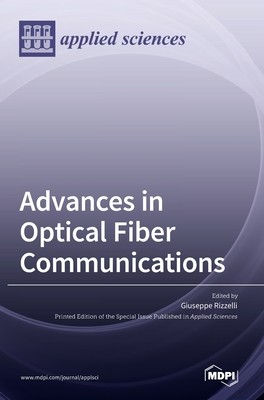
- We will send in 10–14 business days.
- Publisher: MDPI AG
- ISBN-10: 3036549471
- ISBN-13: 9783036549477
- Format: 17 x 24.4 x 1.1 cm, hardcover
- Language: English
- SAVE -10% with code: EXTRA
Advances in Optical Fiber Communications (e-book) (used book) | bookbook.eu
Reviews
Description
Given the increasing importance of a globally interconnected world, driven by modern digital services and the need for fast and reliable access to digital resources, communication networks are one of the key infrastructures in today's society. In this scenario, fiber optics and optical devices play a leading role, as they allow for unprecedented growth in our capacity to cope with the ever-increasing traffic demand.
Optical transmission solutions range from high-speed networks based on coherent detection and advanced modulation formats for long-haul-level communications, to networks still relying on traditional intensity modulation and direct detection receivers for short-reach communications, down to intra-data center scenarios. In between there is a whole gamut of network architectures, providing different solutions for specific applications, targeting the minimization of cost-per-bit as a trade-off between capacity and overall implementation cost, in order for operators to cope with the increasing traffic demand while still providing reasonable market accessibility.
Currently, most communications rely on optical technologies, and the worldwide goal is the optimum trade-off between transmission speed and cost-per-bit. This is usually pursued by i) manufacturing low-cost devices, ii) the introduction of digital solutions to overcome the physical limitations of optical communications systems and iii) the optimization of network design.
Contributions to this Special Issue address these three subjects, and provide valuable insights into the optical fiber communications world.
- Publisher: MDPI AG
- ISBN-10: 3036549471
- ISBN-13: 9783036549477
- Format: 17 x 24.4 x 1.1 cm, hardcover
- Language: English English
Given the increasing importance of a globally interconnected world, driven by modern digital services and the need for fast and reliable access to digital resources, communication networks are one of the key infrastructures in today's society. In this scenario, fiber optics and optical devices play a leading role, as they allow for unprecedented growth in our capacity to cope with the ever-increasing traffic demand.
Optical transmission solutions range from high-speed networks based on coherent detection and advanced modulation formats for long-haul-level communications, to networks still relying on traditional intensity modulation and direct detection receivers for short-reach communications, down to intra-data center scenarios. In between there is a whole gamut of network architectures, providing different solutions for specific applications, targeting the minimization of cost-per-bit as a trade-off between capacity and overall implementation cost, in order for operators to cope with the increasing traffic demand while still providing reasonable market accessibility.
Currently, most communications rely on optical technologies, and the worldwide goal is the optimum trade-off between transmission speed and cost-per-bit. This is usually pursued by i) manufacturing low-cost devices, ii) the introduction of digital solutions to overcome the physical limitations of optical communications systems and iii) the optimization of network design.
Contributions to this Special Issue address these three subjects, and provide valuable insights into the optical fiber communications world.


Reviews